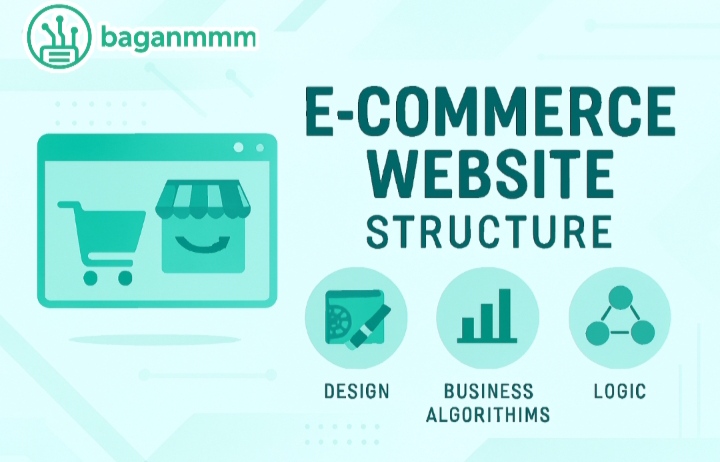E-commerce (Electronic Commerce) is the abbreviation for Electronic Commerce, and it allows for the easy buying and selling of goods and services over the internet.
It is an online business where the buying, selling of goods and services, and payments are typically carried out through online platforms and websites.
Customers and sellers, using phones, computers, and other smart devices, can buy and sell any kind of goods or services from anywhere in the world in a short amount of time. The payment process is also simple, easy, and transparent.
Therefore, today’s E-commerce businesses are more effective and successful than traditional buying and selling businesses.
Your goods or services can easily reach consumers all over the world, and you can easily purchase the goods and services you need. Furthermore, all aspects of the business, such as product management, payment management, and delivery management, can be easily carried out on E-commerce platforms.
Some well-known e-commerce platforms are Amazon, eBay, Alibaba, and Shopify. These platforms can effectively manage buying, selling, providing services, receiving services, payments, and delivery—all in one place for you.

This is a brief overview of the E-commerce system. Next, I will explain some of the well-known features of the E-commerce system in detail.
1. Selling Products
You can sell your own products or resell others’ products for profit. Since it can provide 24/7 service to a global market, it’s one of the most effective platforms from a marketing strategy standpoint.
2. Building a Brand
If you want to establish your brand firmly in the global market, an e‑commerce website is essential. All the world’s leading brands use this method.
Examples: Apple, Samsung, Nike, Adidas, Manchester United each has its own e‑commerce platform.
3. Customer Services
E‑commerce websites can provide 24/7 customer service. With the integration of AI, they now deliver even greater customer satisfaction, increase brand awareness, and boost user engagement.
4. Modern Marketing Methods
Unlike traditional methods, e‑commerce websites can integrate the latest technologies, making them a must‑have in today’s marketing strategies. In fact, many of today’s trending artificial marketing techniques are built on e‑commerce platforms.
These are the benefits of e‑commerce websites from the user’s perspective.
The main point of this blog is about e‑commerce website structure thinking. When building such websites, developers must understand the technical requirements, theoretical foundations, and even government‑related compliance factors. Only then can they create a truly powerful e‑commerce platform.
In particular, developers should master areas such as website structure, data management, security, user behavior, and data analytics. Other aspects, like marketing theories and government regulations, are primarily the responsibility of marketing specialists.
Since this blog is focused on developers, I’ve shared the key points that developers need to know about e‑commerce websites, based on my own experience and current technological demands.
If you’re a junior developer, this blog will introduce you to new ways of thinking and problem‑solving. It also breaks down the essential layers and decision‑making processes required to build a successful e‑commerce platform.
1. Structure: The Blueprint of Your E‑Commerce Website
Think of your e‑commerce site like a building without a solid blueprint, it won’t stand the test of time. Your site structure determines how information flows, how users navigate, and how your backend systems interact.
Key Structural Layers
1. Presentation Layer (Front‑End)
- What customers see and interact with: product pages, search results, shopping cart, checkout.
- Built with responsive design for mobile, tablet, and desktop.
- Uses frameworks like React, Vue, or Angular for dynamic, fast-loading interfaces.
2. Application Layer (Business Logic)
- Handles product filtering, pricing rules, promotions, and checkout workflows.
- Manages user authentication, order processing, and inventory updates.
- Often built with frameworks like Laravel, Django, or Node.js.
3. Data Layer (Database & Storage)
- Stores product catalogs, customer profiles, order history, and transaction data.
- Uses relational databases (MySQL, PostgreSQL) or NoSQL (MongoDB) for scalability.
- Includes secure backups and redundancy for reliability.
4. Integration Layer
- Connects payment gateways, shipping APIs, CRM, ERP, and marketing tools.
- Enables automation and real-time updates across systems.
2. Thinking: Strategic Planning for User Experience & Growth
Before writing a single line of code, you need strategic thinking to align your website with your business goals and customer expectations.
Core Considerations
User Journey Mapping
Identify how customers find products, compare options, and complete purchases.
Optimize for minimal clicks and frictionless checkout.
Scalability Planning
Design for growth your architecture should handle traffic spikes during sales events like Black Friday without crashing.
SEO & Discoverability
Structure URLs, categories, and metadata for search engine indexing.
Use clean navigation hierarchies to help both users and crawlers.
Security & Compliance
Implement SSL, PCI DSS compliance, and GDPR/CCPA data protection measures.
Build trust with visible security badges and transparent policies.
3. Logic: The Engine That Powers Your Store
The logic of an e‑commerce site is the set of rules and processes that make it function smoothly from adding an item to the cart to sending a shipping confirmation.
Examples of E‑Commerce Logic
- Product Logic
- Dynamic pricing based on promotions, stock levels, or customer segments.
- Real-time inventory updates to prevent overselling.
- Cart & Checkout Logic
- Automatic tax and shipping calculations based on location.
- Coupon validation and discount application.
- Abandoned cart reminders via email or push notifications.
- Order Fulfillment Logic
- Routing orders to the nearest warehouse for faster delivery.
- Triggering status updates and tracking links.
- Personalization Logic
- Recommending products based on browsing history or past purchases.
- Adjusting homepage banners for returning customers.
Recommended Architectural Patterns
Three‑Tier Architecture: Separates presentation, application, and data layers for scalability and maintainability.
Microservices Architecture: Breaks the platform into independent services (e.g., payments, search, recommendations) for flexibility.
Headless Commerce: Decouples the front‑end from the back‑end, allowing multiple front‑end experiences (web, mobile app, kiosk) to use the same backend.
Final Thought
A successful e‑commerce website is not just about having a beautiful design. It is primarily built on three key factors: structural organization, marketing strategy, and technical accuracy.
Even if an e‑commerce site looks attractive, if it fails to provide clear information for users, has errors in the payment process, or does not highlight the products users actually need, the system will fail. That’s why these three factors are so important.
1. Website Structure
Your site must be systematically organized. From the very beginning, it should be built with a dynamic structure that can scale and expand as needed. It should also be designed in a way that aligns with user behavior. To achieve this, the structure should be based on data analytics that track and interpret user behavior.
2. Marketing Strategy
Your platform must be built around the needs of your users. This means understanding different audience segments such as location, age, gender, and active time. Platforms like Facebook, X (Twitter), Instagram, and TikTok all attract users by leveraging this kind of audience data.
3. Technical Accuracy
Purchasing and transactions are built on trust. Customers must feel confident in your platform. Therefore, the payment system must be accurate, simple, and smooth. Complicated or unreliable payment processes frustrate users and reduce trust.
Because of this, these three areas must be carefully prepared. And it cannot be done by a single web developer alone — it requires collaboration with specialists from different fields.
These are the fundamental considerations required for building a successful e‑commerce website. E‑commerce platforms are technically complex, strategically broad in marketing, and further complicated by government regulations and legal compliance.
This blog attempts to explain these complexities in a structured way, based on my own experience. It does not cover the entire e‑commerce system, but focuses on the role and responsibilities of web developers within it.
If you are a web developer, this blog will be useful for both building and studying e‑commerce platforms.
Alice is the visionary behind Baganmmm Tech, a platform he founded with a passion for demystifying the complex world of technology. As the Lead Technologist, he's often found in his home lab – a cozy, wire-filled sanctuary where ideas are born and code is meticulously crafted. His infectious enthusiasm and knack for explaining intricate concepts make him the go-to expert for everything from web development to emerging tech trends.
